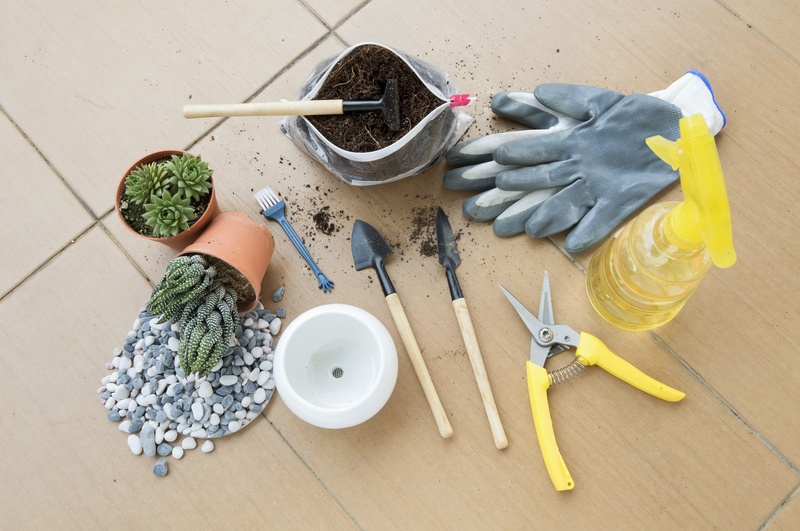Combatting Summer Drought Stress: Lawn Survival Guide
Is your once lush, green lawn starting to brown under the relentless summer sun? Summer drought stress can quickly turn your beautiful yard into a dry, patchy landscape. But don't worry--this comprehensive guide is packed with proven strategies and expert tips to help your lawn survive, and even thrive, during hot, dry weather. Whether you're a new homeowner or a seasoned gardener, read on to discover everything you need to know about combatting summer drought stress for your lawn.
Understanding Lawn Drought Stress
The first step in managing summertime drought conditions is understanding the signs and causes of drought stress in your grass. Prolonged periods of heat and minimal rainfall force turfgrass into a state of decline, leaving it vulnerable to further damage.
What Is Drought Stress?
Drought stress refers to the physiological strain that occurs when your lawn receives less water than it needs to stay healthy. During heatwaves and dry spells, water in the soil evaporates quickly, and grass roots struggle to absorb enough moisture.
- Wilting blades and a bluish-gray tint
- Crispy or folded grass leaves
- Patchy brown or thin areas
- Slow growth, even after fertilizing
If you notice any of these warning signs of drought stress in your lawn, it's time to take action!

Best Lawn Types for Drought-Resistance
While no turf is completely immune to drought, some grass types cope much better than others. Selecting a grass species that's naturally drought-tolerant is your first line of defense.
Top Drought-Tolerant Grass Varieties
- Bermuda Grass: Warm-season, thrives under heat and recovers quickly.
- Zoysia Grass: Dense-growing, deep roots help conserve soil moisture.
- Buffalo Grass: Excellent for hot, arid climates; low water needs.
- Tall Fescue: Cool-season, but has deep roots for efficient water use.
Overseeding with drought-resistant varieties can help fortify your existing lawn against future drought events.
Watering Strategies During Drought
Effective irrigation is the cornerstone of surviving summer drought stress. However, not all watering techniques are equal. Let's explore expert-endorsed strategies to maximize water efficiency and promote root health.
How Much and How Often Should You Water Your Lawn?
If you have water restrictions in your area, watering deeply but less frequently is best. This encourages roots to grow deeper, tapping into moisture reserves hidden in the soil.
- Optimal Amount: Aim for 1 to 1.5 inches of water per week, including rain.
- Best Time to Water: Early morning (before 9 am) reduces evaporation.
- How to Measure: Use a rain gauge or small containers to track how much water your lawn receives.
Pro Tip: Avoid watering during midday heat or windy hours--much of the water will simply evaporate!
Efficient Irrigation Methods
- Soaker Hoses: Deliver water directly at soil level with minimal loss to evaporation.
- Drip Irrigation: Great for garden beds or slopes, reducing water runoff.
- Smart Timers & Sensors: Modern irrigation systems can adapt watering schedules based on real-time weather data.
Adjust your regular watering schedule as drought conditions and local regulations change.
Mowing Practices for Drought Survival
The way you mow your lawn during dry spells affects its ability to withstand drought stress.
Key Lawn Mowing Tips during Drought
- Raise the Cutting Height: Allow grass to grow taller (3-4 inches) to shade the soil, reduce evaporation, and promote deeper rooting.
- Keep Blades Sharp: Dull blades tear grass, causing stress and increasing water loss.
- Follow the 1/3 Rule: Never remove more than one-third of the grass height at a time to avoid shock.
- Leave Grass Clippings: Mulched clippings conserve moisture and return nutrients.
Remember: Abstain from mowing during extreme drought. Give grass time to recover if it's dormant or crispy brown.
Soil Health and Lawn Care During Drought
Healthy soil is the foundation of a drought-resilient lawn. Improving soil structure and fertility increases water retention, minimizes runoff, and helps roots access moisture longer.
How to Improve Lawn Soil
- Add Organic Matter: Top dress with compost or use organic mulch to boost water retention.
- Aerate Your Lawn: Aeration relieves compacted turf and opens pathways for water to penetrate deeply.
- Correct pH Imbalances: Test soil and amend as needed for optimum grass health.
- Mulch Around Trees and Edges: Mulched zones keep roots cooler and moister for longer.
Fertilizing Do's and Don'ts in Drought
Applying fertilizer during drought can do more harm than good if not performed carefully. Here's how to support your lawn without adding undue stress.
- DO: Fertilize in early spring or fall, not during peak summer drought.
- DO: Use slow-release, organic fertilizers to avoid burning roots.
- DON'T: Over-fertilize--excess nutrients require more water for absorption.
- DON'T: Fertilize dormant or brown lawns; wait until recovery begins and regular rainfall returns.
Essential Lawn Feeding Tips
Apply fertilizers only when soil is moist, and water it in well. Light, balanced feedings are preferable over heavy, infrequent applications.
Managing Lawn Weeds and Pests During Drought
Weeds and pests thrive in drought-stressed lawns, where thin turf and open soil provide easy entry points.
- Spot Treat Weeds: Hand pull or apply targeted herbicides to prevent invasive spread.
- Watch for Grubs and Chinch Bugs: Look for spongy turf or irregular brown patches; treat with appropriate pest controls as needed.
- Encourage Lawn Density: Healthy, thick grass naturally crowds out weeds and insects.
Monitor your lawn closely and address small issues quickly before they escalate during drought stress.
Lawn Dormancy: A Survival Mechanism
As a natural response, most grasses enter a form of dormancy during prolonged drought. Blades turn brown, and growth slows or stops, but roots remain alive and ready to regrow when moisture returns.
- Don't panic if your lawn turns brown!
- Limit traffic: Dormant grass is vulnerable to physical damage.
- Resume regular care when rain returns: Grass usually recovers with persistent, gentle care.
If drought continues beyond 4-6 weeks, water your lawn to provide minimal survival moisture--usually about 1/2 inch every 2-3 weeks.
New Lawns: Drought-Proofing from the Start
Planning a new lawn installation? Choosing drought-wise solutions from the outset maximizes long-term resilience.
- Select Deep Rooting Varieties: As covered earlier, these withstand water deficits best.
- Prepare Soil Thoroughly: Remove debris, amend with compost, and test for proper pH.
- Seed or Sod in Fall or Early Spring: Establishment is easier under cool, moist conditions.
- Water Consistently: Young grass must not dry out during establishment--use light, frequent irrigation and mulch to retain soil moisture.
Consider Grass Alternatives
If maintaining a traditional lawn proves too challenging in your region, consider ground covers like clover, sedges, or native wildflowers--these require less water and provide ecological benefits.
Top 10 Tips for Combatting Summer Drought Stress on Your Lawn
- Choose drought-tolerant grasses for new plantings or overseeding.
- Water early in the morning, and water deeply to encourage strong root systems.
- Raise mower height to shade soil and conserve moisture.
- Avoid heavy traffic on stressed or dormant turf.
- Improve soil with organic matter and aerate to reduce compaction.
- Fertilize wisely--avoid during peak heat and drought.
- Spot treat weeds and monitor for pests regularly.
- Mulch around trees and edges to help roots retain moisture.
- Don't overwater--too much or too little can harm your lawn.
- Let dormant lawns rest and avoid unnecessary mowing or fertilizing.
Eco-Friendly Solutions for Drought-Stressed Lawns
Save water, lower costs, and boost your yard's climate resilience by integrating long-term, sustainable strategies:
- Install Rain Barrels: Collect and reuse rainwater for lawn and garden watering.
- Landscape with Native Plants: Native species require less supplemental watering.
- Create "Lawn-Free" Zones: Incorporate drought-hardy shrubs, pathways, or decorative gravel to reduce turf area.
- Apply Wetting Agents: Some eco-friendly soil products improve water penetration and distribution.

Frequently Asked Questions on Lawn Drought Survival
Can I revive a dead lawn after drought?
If your grass roots are still alive, it will usually bounce back with rain and proper care. If the roots are completely dead (no green tissue remains after several weeks of watering), reseeding or resodding may be necessary.
Should I keep watering a brown, dormant lawn?
Minimal monthly watering can help lawns survive extended dormancy. Apply enough to keep roots alive. Avoid overwatering, which wastes water and leads to disease.
Is it OK to fertilize during a drought?
Generally, do not apply fertilizer to drought-stressed or brown grass. Wait until active growth resumes and supplement only as needed with water-soluble nutrients.
How do I prevent weeds when my lawn is stressed?
Keep your lawn dense and healthy, promptly remove weeds, and avoid disturbing the soil surface to discourage germination of weed seeds.
Conclusion: Keep Your Lawn Green Through Drought
With the right approach, combatting summer drought stress is possible. Choose resilient grass types, optimize your watering and mowing, focus on soil health, and adapt your maintenance routine as the weather changes. Even if your lawn enters dormancy, patience and care will help it recover once moisture returns.
Start implementing our Lawn Survival Guide today, and enjoy a healthier, more resilient lawn even in the face of summer drought!
For more lawn drought survival tips and expert guidance, follow our blog or contact your local extension service for region-specific advice.